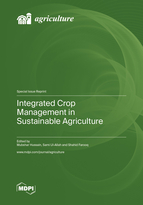Integrated Crop Management in Sustainable Agriculture
A special issue of Agriculture (ISSN 2077-0472). This special issue belongs to the section "Crop Production".
Deadline for manuscript submissions: closed (25 October 2022) | Viewed by 37009
Special Issue Editors
Interests: crop production under stressful environments; seed priming; biochar; allelopathy;cropping systems; conservation agriculture; crop nutrition and agronomic biofortification
Interests: crop improvement; cropping systems; yield and nutritional quality; abiotic stress tolerance
Special Issue Information
Dear Colleagues,
The rapidly increasing global population has led to the establishment of new residential colonies on productive agricultural lands, resulting in a significant reduction in the cropped area. Furthermore, rapid changes in the regional and global climates are resulting in multiple stresses, making crop production more challenging. These factors necessitate sustainable agricultural production from the existing cropped areas. Numerous strategies are being used to sustain agricultural production, including development of climate-resilient genotypes, integrated soil and crop management, etc. Integrated crop management involves several eco-friendly measures put together for sustaining production. These may include a combination of any of the options, i.e., seed priming, application of organic and inorganic amendments, use of rhizobacteria, application of macro and micronutrients, biofortification, good management practices, etc. Integration of these management practices leads to improved soil health and crop productivity. However, the benefits of integrated crop management are largely influenced by environment, soil type and fertility, and crop type. Mono-cropping systems or the use of the same crop rotation lead to reduced soil quality, favoring insect pests’ infestation and reducing farm profits. Combination of exhaustive and restorative crops in rotation as well as in intercropping and relay cropping improves soil quality, crop nutrition, sustains crop production and ultimately leads to higher net returns. Therefore, the benefits of integrated crop management should be considered on a long-term basis not for the short-term yield response.
This Special Issue will focus on the impacts of integrated crop management practices on soil health, crop productivity, and a reduction in the impacts of expected climate changes on crop production in a sustainable manner. Research and review articles focusing on any of the above-described aspects will be gladly considered in this Special Issue.
Prof. Dr. Mubshar Hussain
Dr. Sami Ul-Allah
Dr. Shahid Farooq
Guest Editors
Manuscript Submission Information
Manuscripts should be submitted online at www.mdpi.com by registering and logging in to this website. Once you are registered, click here to go to the submission form. Manuscripts can be submitted until the deadline. All submissions that pass pre-check are peer-reviewed. Accepted papers will be published continuously in the journal (as soon as accepted) and will be listed together on the special issue website. Research articles, review articles as well as short communications are invited. For planned papers, a title and short abstract (about 100 words) can be sent to the Editorial Office for announcement on this website.
Submitted manuscripts should not have been published previously, nor be under consideration for publication elsewhere (except conference proceedings papers). All manuscripts are thoroughly refereed through a single-blind peer-review process. A guide for authors and other relevant information for submission of manuscripts is available on the Instructions for Authors page. Agriculture is an international peer-reviewed open access monthly journal published by MDPI.
Please visit the Instructions for Authors page before submitting a manuscript. The Article Processing Charge (APC) for publication in this open access journal is 2600 CHF (Swiss Francs). Submitted papers should be well formatted and use good English. Authors may use MDPI's English editing service prior to publication or during author revisions.
Keywords
- integrated crop management
- intercropping
- relay cropping
- crop rotation
- soil quality
- climate change
- biotic and abiotic stresses
- seed priming
- seed inoculation
- beneficial microbes
- climate-resilient crop varieties
- biochar
- sowing time
- planting density
- canopy cover







